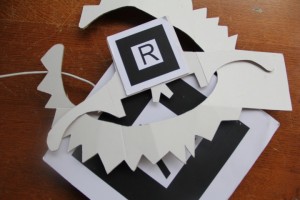 Applications of Augmented Reality to education at any level are starting to change the way students learn to do things in many learning areas.
Applications of Augmented Reality to education at any level are starting to change the way students learn to do things in many learning areas.
During the 2011-2012 season, the Cultural Center Saint-Exupéry from Reims, France, developed an educational project especially targeted to primary school children. The idea was to create a Pedagogical Briefcase to empower children artistically and playfully with emerging technologies skills. The project relies on the Augmented Reality Plugin for SketchUp.
To develop the project, the Saint-Exupery Centre chose to work with the artist Jean Bigot, who works on the relationship between objects and imagination. As the artist likes to create false stories with false objects (collection Jean Bigot, co-production France 3, 2010) the idea was to create a story from mock objects in 3D that become someway real.
After a presentation to La Maison Des Métallos in Paris, France, during an evening MCDATE (monthly appointments around digital art organized by MCD – Musique et Cultures Digitales) in November 2011, a first experimentation was developed with a class of the primary school ”Trois Fontaines” in Reims. Ten workshop sessions of two hours each were held.
The Pedagogical Briefcase is organized in seven steps:
1st step.
Discovery of augmented reality.
Immersive journey for experimentation.
2nd step.
Presentation of different types of use of the augmented reality.
-Commercial:
Animation of the Futuroscope, advertising, mobile services, e-commerce, Geolocation, etc.
-Artistic:
Chris’ O’Shea, Donald Abad (Flying Babel), Sacho Plan, James Jarvis, the Ascii LIfe creators, the beginnings of virtual reality with Christa Sommerer and Laurent Mignonneau, Maurice Benayoun, Sander Veenhof, Raphael Isdant, Martin Kovacovsky, or even Adelin Schweitzer, Akitsugu Maebayashi, etc.
Since the accessibility of the educational toolbox had to be universal as well as playful and attractive for children, a first direct experience of augmented reality is offered to kids during this first session.
3rd step.
Further discovery of the computer tools related to this educational kit:
-The computer, the webcam.
-The markers.
-The AR-Media and Sketchup Plugin.
-The database of 3d models.
4th step.
Discussions with kids to determine the choice and direction of the project.
Write the script and programming of the project defined, taking into account educational constraints.
5th step.
Production of custom markers.
Association of the “markers” to 3D models.
Integration of the “markers” to the body of the child. Creation of media in cartons (necklaces, glasses, crowns…).
6th stage.
Filming of the movie.
In total, twenty-two scenes were filmed in the grounds of the elementary institution Trois Fontaines from Reims. A total of 20 posted hours.
The result final is a short film of 8’28 ” by the children of the class of CM2 of Ms. Brasseur, with the direction and editing of Jean Bigot, and the E.C.M. team : Olivier Delporte and Pierre Rahola.
7th stage.
A return of the project was carried out for the students of the College Trois Fontaines and parents: screening of the film, attaching photographs of their creations of “markers” made and supports for public testing the augmented reality.
Cultural Center Saint-Exupéry from Reims and the Espace Culture Multimedia of this Cultural Center will make available this augmented reality’s educational Briefcase to all the Champagne Ardenne’s Academy.
The Pedagogical Briefcase includes:
-a database of different 3D models sorted by themes.
-various examples of “markers”.
-fact sheets on the SketchUp 8.0 and AR-Media software.
The educational kit is available through the Visual Arts Section of the Academy from Reims.
AR-Media licenses are installed on their laptop computers, and teachers who have been trained at the beginning of academic year 2012-2013, will, in turn, use this pedagogical briefcase “Imaginaire Virtuel”. It will be for the 2012-2013 year, a test cycle to adjust the contents of the kit with the purpose to do an accessible product for everyone.
As early as September 2013, the Centre cultural Saint-Exupéry de Reims also offers a downloadable version of the kit.
This post is also available in: Italian



